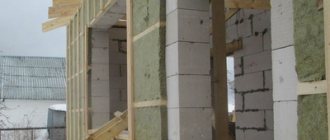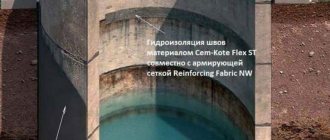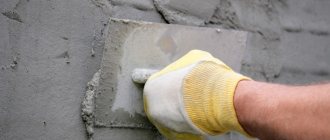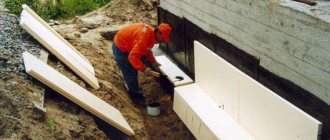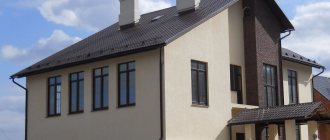The most effective method of insulating walls is external insulation.
Thanks to it, you can retain heat without reducing the area of the room.
An extremely important advantage of this thermal insulation method is that the external walls will retain heat .
Insulation of the external walls of a brick house is the optimal method of thermal insulation of a building.
The following materials are suitable for insulation:
- mineral wool;
- Styrofoam;
- extruded polystyrene foam;
- penoplex;
- penofol;
- penoizol;
- polyurethane foam.
We will look at some of them in this article.
Internal and external insulation - features and nuances
A wall that is insulated from the outside will cool several times slower. The undoubted advantages are:
- Heat losses are minimal;
- The dew point is located either in the insulation itself, or at the edge of the outer wall (it all depends on the parameters);
- Condensation will never form on the wall;
- The wall warms up completely, there are no significant temperature jumps .
Differences in insulation
Internal wall insulation is not considered so popular, all due to a number of significant disadvantages:
- Heat is lost by 10%.
- Dew point location . It is located in the space between the inside of the wall and the insulation or in the insulation itself. This causes condensation to accumulate, and after a while dampness appears in the room.
- The wall does not retain or accumulate heat.
Despite a number of disadvantages, internal insulation is also characterized by positive qualities:
- Work can be carried out at any time of the year, regardless of weather conditions.
- It is easy to carry out insulation yourself; for this you only need basic knowledge and the necessary materials.
Glazing
Windows are not only the eyes of a house, but also one of the ways it loses heat. Even with ideally warm walls, up to 50% of heat can be lost through window structures. Installing high-quality windows is the first step in insulating the entire house. At the same time, properly selected glazing will allow you to warm the room in winter and cool it in summer.
Despite the large selection of models and profiles, PVC windows are popular among homeowners. They are distinguished by high heat and sound insulation properties, durability, functionality, attractive appearance, accessibility and the ability to decorate them in accordance with the wishes of the customer.
Double-glazed windows play an important role in window construction, on which the performance characteristics of the windows depend. We recommend that you learn in detail about double-glazed windows, the principles of their operation and even the rules of selection from the video:
All about double-glazed windows.
Source https://oknanovgoroda.ru/steklopakety
Such interesting and accessible information will help you make your home as comfortable and cozy as possible. We recommend!
Main types of insulation and their brief description
Organic heat insulators on the market are represented by a wide range of products.
They are based on materials of natural origin:
- Arbolite insulation is considered the newest material, which is based on sawdust, shavings, uncut straw and reeds. Also, the insulation is made of cement and organic additives. These are CaCl2, H2SO4, as well as the product obtained after processing ordinary clay, kaolin or nepheline, and Na2O.
- Foam-polyvinyl chloride insulation . It consists of polyvinyl chloride resin, which, after exposure to light or electromagnetic vibrations, acquires a characteristic foam structure. At the same time, it is considered a universal heat insulator.
- Chipboard insulation . Components - shavings, resin obtained as a result of controlled chemical processes, antiseptics, fire retardant.
- Insulation with a fiberboard base . It resembles chipboard in its own way. The base is wood waste, or trimmed corn and straw stalks. The material may well also consist of compressed old paper.
- Polyurethane foam is based on polyester , it includes H2O, an emulsifier and isocyanates. When catalysts begin to act, all elements interact as a result of a chemical reaction, in which a new type of insulation appears.
Inorganic heat insulators
Mineral wool comes in two types: slag and stone . To produce the first, companies use slag. Stone wool is distinguished by: CaCO3, rocks that are used for paving streets, minerals containing calcium and magnesia, volcanic rocks and others.
External insulation of brick walls - how to choose optimal thermal insulation?
Minvata
This concept includes the following varieties:
- glass wool, as well as stone wool;
- slag wool
All these materials are characterized by corresponding fibers, which are based on glass, rocks, and slag.
Averages:
- thermal conductivity – 0.041-0.044 W/(mK);
- impermeability – 20-200 kg/m3.
IMPORTANT!
Before deciding whether to insulate a brick facade with this material, it is necessary to take into account that it is prone to excessive absorption of moisture . Therefore, it is additionally treated with special chemical materials.
Mineral wool
Styrofoam
An oversized material, which, due to its characteristics and affordable price, has become the most popular material for thermal insulation . In the construction market you can always find a copy whose average indicators are:
- thermal conductivity – 0.033-0.037 W/(mK);
- impermeability – 11-35 kg/m3.
Foam plastic is practically free from moisture, plus it is vapor-proof. In addition, the material is quite fragile, easily flammable, and during smoldering it releases many dangerous chemical elements. This material has many disadvantages, but it is ideal as an economical option.
Styrofoam
Extruded polystyrene foam
In terms of its characteristics, the material resembles the foam plastic described above, only there is one difference - exclusively the latest developments are used in its production.
Averages:
- thermal conductivity – 0.028-0.032 W/(mK);
- impermeability – 25-38 kg/m3.
It is often used for external insulation; it is quite strong and retains heat well. Naturally, its cost is several times higher than that of the two options discussed above.
Warm plaster
It is distinguished by sound insulation and vapor permeability.
Characteristics:
- thermal conductivity – 0.065 W/(mK);
- impermeability – 200-340 kg/m3.
This is an ideal insulation material for cladding the external wall of a brick house, but requires special conditions due to its characteristics:
- layer of plaster no more than 50 mm;
- the foundation must be further strengthened.
Plaster
How to insulate a brick house
More often, houses are built from heavy materials - stone, brick, concrete on strong, solid foundations. These materials are excellent for construction, but conduct heat well, so it does not linger inside a brick house in winter, and in summer the building overheats from the sun.
A house made of brick or other heavy materials requires insulation to make it comfortable in all seasons. It must be insulated in accordance with the standard (SNiP), which recommends economically feasible values for the thickness of the insulation - so that heat loss is minimal, with sufficient simplicity and low cost of the house design.
You can make the insulation yourself, which will save a tidy bag of money. There are no major difficulties in the insulation process, but several critical rules must be observed regarding the compatibility of insulation materials and their thickness, otherwise serious damage to the structure may be caused due to the accumulation of moisture.
The amount of work involved in insulating a brick house is quite significant; you need to understand that the work ahead is serious.
Preparatory stage - assessing the condition of the house and choosing insulation
You don’t need to be a specialist to determine how insulated it is when inspecting a brick house. It is enough to know that each structure of the house - windows, doors, floors, walls, ceiling (roof) must have a certain resistance to heat transfer (according to the standard). You can then determine how much insulation is required to achieve this value.
If the structure of the house is made of heat-conducting materials in a thin layer, then the brick house is not just “cold”, but “icy”.
Thin structures made of cold materials can be completely ignored when calculating insulation - they provide such little resistance to heat movement. Therefore, for a house with a 20 mm board ceiling, a 35 mm board floor above a ventilated underground, and 36 cm thick brick walls, the following insulation materials must be used.
How much and where insulation is needed
- on the attic floor - mineral wool with a layer of 22 cm;
- under the floor between wooden joists - mineral wool with a layer of 15 cm;
- on the walls - foam plastic with a layer of 10 cm.
In this case, this house will meet the thermal insulation requirements for a temperate climate. If we are talking about northern regions, the thickness of the insulation should increase by 25 - 50%.
If building materials with low thermal conductivity are used in a thick layer to make a house, for example, porous ceramics, wooden logs..., the thickness of the insulation can be reduced; it is calculated from the condition that the structure achieves standard values for thermal insulation.
The importance of doors and windows
It must be taken into account that a certain percentage of heat is lost through each enclosing structure of a brick house. Windows and doors are record holders in this regard, since they often have through gaps, i.e. a draft is created - heat is carried away by the air.
Also, a lot of heat escapes through windows and doors simply because they are thin, and through windows there is always an increased leakage of radiation energy (infrared radiation).
It is very difficult to make old windows and doors truly warm. It is better to replace them with modern products that meet regulatory requirements for thermal insulation.
Which windows and doors to choose
It is only important to choose two-chamber windows, then the total thickness of the air gap will reach a value of at least 28 mm, which is not bad, considering that dry air is the best heat insulator.
Coated glass reflects a significant portion of the radiation energy back into the room.
It is advisable to choose double doors because the total thickness of the insulation in them will be large - from 10 cm, which is a definite plus. It is only important that both doors are properly sealed around the perimeter. A faulty door seal needs to be replaced on time - this saves a large amount of heat.
Insulating the remaining parts of the house will have only a half-effective effect until the issue with windows and doors is resolved. But if replacement fails, you need to try to insulate the old windows and doors.
Increasing the heat transfer resistance of floors
You can insulate a wooden floor yourself. In most cases, there is a ventilated underground underneath, which always maintains a positive temperature and high humidity, due to the fact that in winter the vents in the foundation close.
Typically, wooden floors are insulated with a layer of mineral wool placed between the joists, with a layer thickness of at least 15 cm.
A vapor barrier should be placed over the mineral wool, followed by a small ventilation gap. If the height of the logs is not enough, then additional strips are nailed onto them.
From below, the mineral wool must be ventilated with a stream of air so that moisture does not accumulate in it; if loose samples of wool are used, then they must also be covered with a vapor diffusion windproof membrane.
Concrete floors
Another flooring option is a concrete base. You can insulate a ready-made concrete base only by raising the floors to the height of the insulation layer and a new screed. Expanded polystyrene 10 cm thick is used, on top of which a cement-sand screed with a thickness of 5 cm or a dry screed made of fiber boards with a thickness of at least 3 cm is laid.
On the ceiling - mineral wool
The ceiling of a brick house can also be insulated with mineral wool, only its layer must be at least 22 cm, since warm air from the room will give off its heat primarily to the ceiling, behind which there is an unheated attic.
In addition, insulating an attic is the easiest way - lower construction costs, hence the more favorable maximum thickness of the insulation.
A layer of cotton wool is placed on a vapor barrier, which prevents the entry of excess moisture generated inside the house. There should also be a ventilation gap above the wool if flooring is provided. Other bulk materials can also be used - vermiculite, cellulose wool, etc. About thermal insulation of ceilings
On the walls - foam plastic
It is easier and cheaper to insulate brick walls with polystyrene foam if they are fairly even, creating a wet façade system.
At the same time, on ordinary brick walls with a thickness of 36 cm, a layer of foam plastic of 10 cm would be quite acceptable. The most difficult moment is leveling the walls so that it is possible to lay the insulation on the glue in an even layer - the facade must be even.
You cannot glue it to plaster - it must first be stripped off. It is important to create a single layer of insulation with minimal gaps between the sheets, with insulation of the end of the wall in the area where the roof is attached, as well as with high-quality insulation of window slopes. For fire reasons, it is recommended to thermally insulate window slopes and 15 cm near window and door openings not with foam plastic, but with sheets of mineral wool.
A durable plaster layer is applied on top of the foam with mandatory reinforcement with a fiberglass mesh, which keeps the surface of the soft foam from stretching. Instructions for installing foam plastic on a brick facade.
Thermal panels
This material is distinguished by both thermal insulation and the ability to cover the surface of walls..
Characteristics:
- thermal conductivity – 0.025 W/(mK);
- impermeability – 45-55 kg/m3.
NOTE!
Today on the market you can find panels that are produced as imitation siding or lining. They are covered with a special quartz coating.
Thermal panels
Pie wall - what elements does a brick wall consist of?
- Plaster - from 10 to 35 mm depending on the chosen option for the brick wall;
- Hollow or solid brick;
- Foam plastic PSB 25 (from 70 to 120 mm);
- Steel lathing;
- Vapor barrier and wind barrier multifunctional membrane.
- Plaster or mortar known;
- External finishing - facing brick or decorative plaster.
wall pie
Consequences of wrong choice or poor quality material
The work of insulating a brick house is not difficult; home craftsmen can do it on their own. The material for the production of insulation systems is also not in short supply and is available to users in all regions of Russia. But the cost of insulation work is expensive.
If you choose the wrong building material or violate the installation technology, then the effect of such work can be, at best, zero, and maybe even negative . Then the dew point in the house will be disturbed and it will “float” from condensation, thereby creating a threat to the load-bearing walls and foundation.
You will find everything you need to know about insulating brick walls in this section.
A few words about waterproofing and vapor barrier
At the stage of thermal insulation of the wall, it is necessary to pay special attention to the vapor barrier, otherwise the insulating material will become unusable after some time. The classic material for vapor barrier is polyethylene.
When installing, you must handle it extremely carefully and do not pull it too hard, otherwise the film may become deformed, especially during seasonal changes in climatic conditions.
Waterproofing
A frequently used vapor barrier material is considered to be mastics specially created for this purpose. If they are applied to the wall, they will allow air to pass through while retaining moisture. Waterproofing protects various building structures from moisture penetration. It is easy to apply, does not require special qualifications from workers, and does not form seams.
For brick walls, plaster is often used instead of vapor barrier, which is not very true in the case of mineral wool, because the insulation will begin to dampen.
Vapor barrier and waterproofing
Sealing cracks and preparing sheathing
It is better to replace damaged walls or carry out major repairs. Gaps in joints are sealed with natural materials or synthetic stone sealants .
Before insulating the wall, you need to take care of preparing the sheathing. The distance between its bars should be determined based on the width of the insulation slab . It is important to use a building level to check the vertical and horizontal surface for finishing. The sheathing bars should be directed perpendicular to the direction of the facing panel.
Brick wall sheathing
Do not forget about installing transverse sheathing to ensure high-quality ventilation.
For the convenience of installing intermediate elements of the sheathing, a rope is pulled from the corner beam from below and above the facade . Some people mark future elements with chalk.
Standard length, width and thickness of bricks
Since bricks have their own standard dimensions (6.5 x 12 x 25), the thickness of the brick wall will have several standard dimensions, taking into account the thickness of the seam between adjacent bricks.
There are other sizes, but they mainly differ in height, and the height of the brick does not affect the thickness of the wall.
Standard dimensions of a brick wall
| Number of bricks, pcs | Wall thickness, cm |
| 0,5 | 12 |
| 1 | 25 |
| 1,5 | 38 |
| 2 | 51 |
| 2,5 | 64 |
In addition to the thickness of 65 mm, there are brick thicknesses of 88 mm - one-and-a-half bricks and 138 mm - double bricks. Those. sizes 8.8x12x25 and 13.8x12x25. In general, the thickness (height) of the brick does not in any way affect the thickness of the brickwork.
The main criterion when choosing the thickness of a brick wall is the purpose and location of the wall itself.
Insulation of a brick wall from the outside using mineral wool as an example
- On the outside, the brick base must be sheathed with OSB boards ; gaps must be maintained between them, the size of which is indicated by the manufacturer. After installation, the gaps are filled with foam.
- Then, on the outside, a membrane with waterproofing is stretched, which protects the mineral wool from moisture , on top of which all exterior finishing will be carried out. Many companies produce waterproofing materials with strips on which connecting elements are applied for a tighter joint. If such strips are missing, the joints should be glued with double-sided tape.
- Then sheets of mineral wool are tightly installed . Often a material is used whose density starts at 35-50 kg/m3. A material with a lower density will certainly settle or roll off, which will cause cold to pass through the formed voids.
- Mineral wool slabs are installed so that the previous mine connections are covered. by 150-200 mm. The overall insulation thickness is based on climate and temperature indicators, but the average is 150 mm.
- After laying the sealant into the walls, all voids that appear are filled with film for installation.
Insulation with mineral wool
Insulation under siding
Performing thermal insulation work
Technologies for carrying out installation work are selected based on the selected type of insulation and method of decorative finishing. In particular, with mortars or lathing. Let's look at the methods using examples of three groups of materials.
Using mineral wool
Fiber insulation is characterized by softness, so lathing is required here. The material is immersed in the cells and further strengthened by “fungi”. To protect the insulator, a water barrier is formed or a vapor-permeable membrane is laid. After filling the counter-lattice, decorative finishing is carried out using modern cladding materials.
Insulation of external walls with mineral wool
Foam insulation
If you plan to sheathe the walls, then the insulation technique is similar to when working with mineral wool. The only difference is the additional foaming of the installation gaps between the slabs and the sheathing. They are needed to compensate for the thermal expansion of dissimilar materials.
The second method is gluing the slabs with glue. Before this, the walls are leveled and primed with an adhesive compound. The solution is applied to the insulation or base in an even layer. The canvases are pressed using a rule in order to subsequently waste less leveling plaster. After the adhesive mass has dried, the insulator is additionally secured with dowels with a wide head (red “fungi” are considered the best).
Applying warm plaster
Preparation of the base is carried out by analogy with the method of insulating brick walls using the “wet” facade system. The difference is that warm plaster is applied to a previously wetted surface. The base is covered with reinforcing mesh. A homogeneous mixture is suitable for work within 1.5-2 hours.
Insulation of external walls with warm plaster
The distribution of the mass is carried out with a painting tool. Drying between layers takes approximately 4 hours. Complete drying of the finished coating occurs within 28 days.
Thermal insulation with polystyrene foam and polyurethane foam - basic principles
Today, many builders insulate their facades with extruded polystyrene foam. The slabs are laid taking into account the degree of horizontality . Sags will ideally cope with the task. When installing the slab, it is extremely necessary to pay attention to maintaining the uniformity of the profile strip; for this, a building level is used.
The joining of the slabs is carried out according to the principle of brickwork, in other words, you need to mount half the slab through each row . The cracks are sealed with liquid polystyrene and pieces of polystyrene foam, but it is better not to use polyurethane foam. If the slabs are poorly joined, this can be easily corrected with a float.
Foam boards are attached with glue, but do not forget about special dowels with caps. Otherwise, due to strong gusts of wind, the slabs will fall off.
As for polyurethane foam, this is a new generation material that:
- Is non-toxic and environmentally friendly;
- Does not lose its characteristics for a long time and lasts for more than half a century;
- It hardens in a short period of time, thanks to this the installation time is significantly reduced;
- Insulation materials based on Polyurethane are completely safe for health. After hardening, this material becomes environmentally friendly;
- Thermal insulation with polyurethane foam is characterized by the lowest possible flammability when compared with other types of insulation;
- Polyurethane foam is not capable of transmitting or absorbing moisture. Thanks to excellent thermal insulation, home owners are free from problems associated with the formation of condensation, mold and mildew.
Thermal insulation with polystyrene foam
Thermal insulation PPU
Insulating a brick house from the outside has a number of advantages. The main thing is to choose the right material and use it rationally, taking into account all the subtleties.


